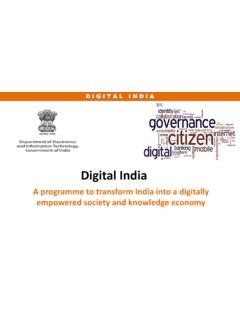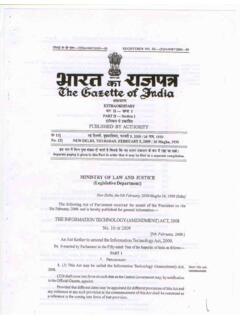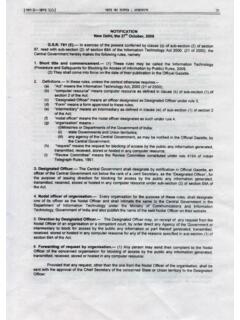Transcription of Electronic Waste and India - Ministry of Electronics and ...
1 Electronic Waste and India Dr. S. Chatterjee Scientist-E Department of Information Technology Electronics Niketan, 6, Complex New Delhi-110 003, India , Abstract Electronic Waste (e- Waste ) is one of the fastest growing Waste streams in the country. Growth of Information and Communication Technology sector has enhanced the usage of the Electronic equipment exponentially. Faster obsolescence and subsequent up-gradation of Electronics product, are forcing consumers to discard old products, which in turn accumulate huge e- Waste to the solid Waste stream. E- Waste is growing in India at the rate of 10%. Major recycling of e- Waste is carried out in the non-formal sector using primitive and hazardous methods. Adequate legislative measures and cost-effective, environmental friendly, technological solution would be needed to address the issue.
2 This article provides the basic information on Electronic Waste management in India . 1. Introduction The discarded and end-of-life Electronics products ranging from computers, equipment used in Information and Communication Technology (ICT), home appliances, audio and video products and all of their peripherals are popularly known as Electronic Waste (E- Waste ). There is, however, no standard or generally accepted definition of e- Waste in the world. In most cases, e- Waste comprises of the relatively expensive and essentially durable products used for data processing, telecommunications or entertainment in private households and businesses. E- Waste is not hazardous if it is stocked in safe storage or recycled by scientific methods or transported from one place to the other in parts or in totality in the formal sector.
3 The e- Waste can, however, be considered hazardous if recycled by primitive methods. E- Waste contains several substances such as heavy metals, plastics, glass etc., which can be potentially toxic and hazardous to the environment and human health, if not handled in an environmentally sound manner. E- Waste recycling in the non-formal sector by primitive methods can damage the environment. The ill effects of e- Waste could be on soil through leaching of hazardous contents from landfills; in water due to contamination of rivers, wells and other water sources; in air due to emission of gases and burning of e- Waste . The recycling process, if not carried out properly, can cause damage to human being through inhalation of gases during recycling, contact of the skin of the workers with hazardous substances and contact during acid treatment used in recovery process.
4 The hazardous and toxic substances found in e- Waste include lead (Pb) and cadmium (Cd) in printed circuit boards (PCBs). Lead is primarily found in all Electronic products/ assembly, cathode ray tubes (CRT) etc. Cadmium is found in monitor/ CRTs while there may be mercury in switches and flat screen monitors. Mercury is also found in CFL, relays and some other specific products. Besides the cadmium in computer batteries, cadmium is also used for plating metal enclosures/ metal parts in sub assemblies . Polychlorinated biphenyls are found in capacitors and transformers and as brominated flame retardant on printed circuit boards, plastic casings, cable and polyvinyl chloride (PVC) cable sheathing for insulation and PBD/PBDE in plastic parts of Electronics . No exclusive study has so far been made to know the effect of the e- Waste in the environment.
5 Few NGOs have, however, found that the recycling of e- Waste in non-formal sector is hazardous. These units use primitive, non-scientific, and non-environment-friendly methods. As these units are working in unorganized sector, no data is available to substantiate the fact that they are violating the prevailing laws for labour, environmental protection and industry. Greenpeace had undertaken a survey of the environmental pollution during manufacturing of Electronic products in China, Thailand, Philippines and Mexico (source: ). The study is an assessment on pollution due to the use of some of the hazardous chemicals in the manufacture of Electronic products in these countries. The industries included the printed circuit board and semiconductor chip manufacturing units and various assembly units of television, computers, monitors etc.
6 No such study has been carried out in India . 2. Inventory of Electronics Waste Actual data on generation or import of e- Waste is not currently available in India . Several studies have been conducted by various agencies to find out the inventory of e- Waste in the country. Most of these studies are based on the model of obsolescence of Electronic products, which needs to be validated with the field data. A survey was carried out by the Central Pollution Control Board (CPCB) during 2005. It was estimated that lakh MT of e- Waste was generated in the country in the year 2005, which is expected to increase to about lakh MT by 2012. During 2007, Manufacturers association for Information Technology (MAIT), India and GTZ, India had, however, carried out an inventory on e- Waste , arising out of three products: computers, mobile phones, and televisions. The total quantities of generated e- Waste in India , during 2007, were 3, 32, 979 Metric Tonnes (MT) (Computer: 56324MT, Mobile Phones: 1655MT, and Televisions: 275000MT) (Sources: Report on E- Waste Inventorisation in India , MAIT-GTZ Study, 2007).
7 The finding of the study is given as under: Sr. No. Items Weight (MT) 1 Domestic Generation 332979 2 Imports 50000 3 Total 382979 4 WEEE available for recycling 144143 5 WEEE actual recycled 19000 6 Projected quantity of WEEE by 2011 (without including the imports) 467098 Source: MAIT,GTZ, 2007 Considering the growth rate, the volume of e- Waste will reach nearly million MT by 2015 and 2 million MT by 2025 ( ). : Growth of Ewaste in IndiaYear 2007 2009 2011 2013 2015 2017 2019 2021 2023 20250500100015002000 ThousandsWeight in MT State and City wise Electronics Waste generation in India In India , among top ten cities, Mumbai ranks first in generating e- Waste followed by Delhi, Bangalore, Chennai, Kolkata, Ahmadabad, Hyderabad, Pune, Surat and Nagpur.
8 The 65 cities generate more than 60% of the total generated e- Waste , whereas, 10 states generate 70% of the total e- Waste . The pie chart at is indicates the state wise generation of e- Waste whereas Fig. 3 shows the city wise generation of e- Waste . (Sources: and Guidelines-2007/Front ). 332979 MT1 metric tonnes(MT) = 1000Kg402905 MT487515 MT589893 MT713770 MT863662 MT1045031 MT1264488 MT1530030 MT1851337 MTFig 2 State wise E- Waste Generation in India (Tonnes/year) lh Fig 3 City wise E- Waste Generation in India (Tonnes/year) 3. Legislative Measure Ministry of Environment and Forests (MoEF), Government of India is the nodal agency for policy, planning, promoting and coordinating the environmental programme including Electronics Waste . The management of e- Waste was covered under the Environment and Forests Hazardous Wastes (Management and Handling) Rules 2008.
9 An exclusive notification on E- Waste (Management and Handling) Rules, 2010 under the Environment (Protection) Act, 1986 has been notified ( 1035) on 12th May 2011 to address the safe and environment friendly handing, transporting, storing, recycling of e- Waste and also to reduce the use of hazardous substances during manufacturing of electrical and Electronic equipments. These rules will come into effect on 1st May 2012. The Table 1 provides the salient features of the Rules. The Central Pollution Control Board (CPCB) India had released guidelines during 2008 for environmentally sound management of e- Waste , which should apply to all those who handle the e- Waste . Table 1: Salient features in E- Waste Rule ( 1035) Chapters, schedules and forms Titles Issues Addressed CHAPTER I Preliminary 1.
10 Short title and commencement 2. Application 3. Definitions Chapter discusses the title and commencement of the laws, applicable stakeholders and related definitions of the terminology CHAPTER II Responsibilities 4. Responsibilities of the producer 5. Responsibilities of collection centers 6. Responsibilities of consumer or bulk consumer 7. Responsibilities of dismantler 8. Responsibilities of recycler Responsibilities and the dos and don ts of the stakeholders are discussed in this chapter CHAPTER III Procedure for seeking authorization for handling e-wastes 9. Procedure for grant of authorization to suspend or cancel an authorization 11. Procedure for grant of registration Chapter discusses the procedure and formalities for potential e-wastes handlers to obtain authorization. Procedure for grant of registration at State Pollution Control Board (SPCB) is also discussed. CHAPTER IV Procedure for storage of e- Waste for storage of e- Waste Maximum permissible storage period of e- Waste with any consumer is 180 days.





![भाग II खड 3(i)] भारत का राजप असाधारण](/cache/preview/d/6/0/d/8/4/f/6/thumb-d60d84f6c4746d2c45f0ef25e64de6d5.jpg)




